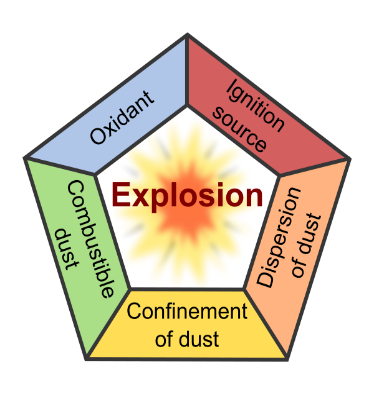
The OSHA has removed their combustible dust standard (1218-AC41) from their regulatory agenda this year. The move comes as a part of Trump’s administration which promised to reduce regulations on the manufacturing industry.
But here at ACS, with think just because the OSHA doesn’t want to talk about dust, doesn’t mean you should sweep it under the rug.
Not only do explosions still mean big, plant destroying, people endangering fires, but OSHA can still issue dust related fines under the Combustible Dust National Emphasis Program.
In order to assess how dangerous your dust is, we’ve compiled a list of National Fire Protection Agency guidelines, along with some of our own tips, as a little refresher crash course. Check it out in the list below.
ACS Deconstructs Deflagration
Deflagration is when combustion occurs as a heat source moves over and ignites cold materials. This creates a fast moving fire that can spread across entire manufacturing lines. With combustible dust, five elements are needed before an explosion happens as shown in the explosion pentagon below:

Fuel: Combustible Dust
Oxidizer: Too much oxygen in your system
An ignition source: Either from friction or material that is too hot
A concentration of dust particles
Confinement of dust
The last two elements can take the form of dust clouds either in the air or resting on your machinery.
What is NFPA 652?
A good alternative to the cancelled OSHA regulations is NFPA 652: The Standard on the Fundamentals of Combustible Dust.
The National Fire Protection Agency (NFPA) published the standard in 2015 to provide clearer guidelines on the handling of a wide range of dusts, as well as which pre-existing standards work best for which industries.
NFPA 652 promotes awareness of the three following principles:
-
Controlling the fuel
-
Controlling the ignition sources
-
Limiting the spread of any combustion event
These three factors are important because they reduce the number of factors from the Dust Explosion Pentagon, and also reduce the effects if an explosion should happen.
DHAs and how to perform them
Dust Hazard Analyses (DHA) are mandatory for new and existing facilities that handle, generate, or store combustible dusts under NFPA 652. They outline what the fire and explosion risks are of each particular dust, and define methods to prevent or mitigate hazards or accidents. See our list of types of DHA’s below.
Types of Dust Hazard Analyses:
-
Hazard Operability Analysis (HAZOP)
-
ASTM E 1226: Standard Test Method for Explosibility of Dust Clouds
-
ASTM E1515: Standard Test method for Minimum Explosible Concentration of Combustible Dusts
Check out our video below for more detailed information on NFPA 652 and DHAs:
Isolation devices & safe valves
Equipment is an integral part of controlling the fuel and ignition sources in your plant, as well as limiting the spread of any combustion event.
Rotary valves are isolation devices, which doesn’t mean they will prevent or protect against combustible dust explosions and deflagration. Under properly maintained conditions, however, they can stop the spread of flames or reduce the amount of oxygen contributing to a blaze.
Here are some things to look for in your rotary valves:
-
Have a minimum of eight vanes, with at least two vanes in contact with each side of the valve housing at all times. This way flames will be contained within the rotor pockets.
-
Keep housing-to-rotor clearances at a compliant 0.0079 inches.
-
Keep a proper maintenance schedule to ensure that clearances are being maintained.
-
Vanes should be 3 mm thick with metal tips. No rubber or plastic tips as they can’t withstand the heat of a fire.
-
Outboard bearings will prevent your valve itself from becoming a fuel source by reducing material build-up.
-
Outboard bearings can also come with a temperature switch to stop the valves when excessive heat is detected.
-
Keep your rotors moving at speeds lower than one metre per second or 200 rpm to avoid your material heating up or igniting.


